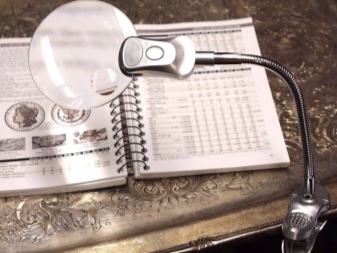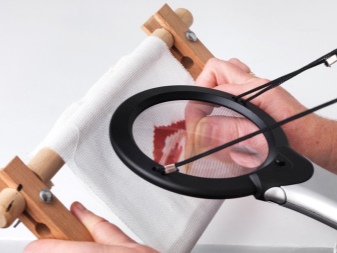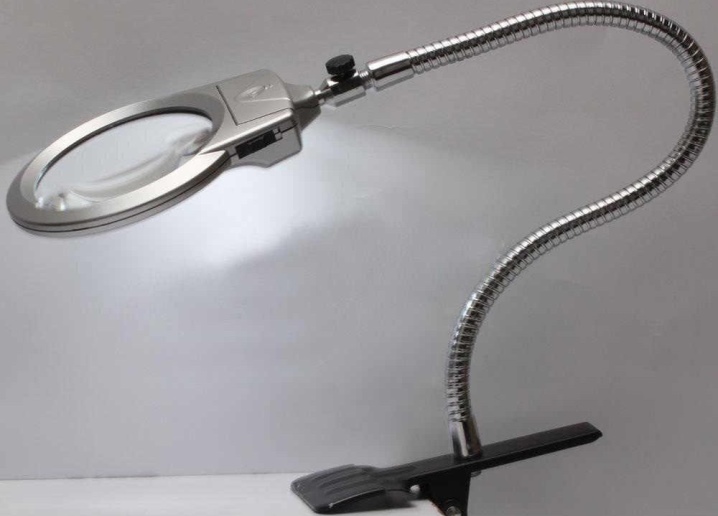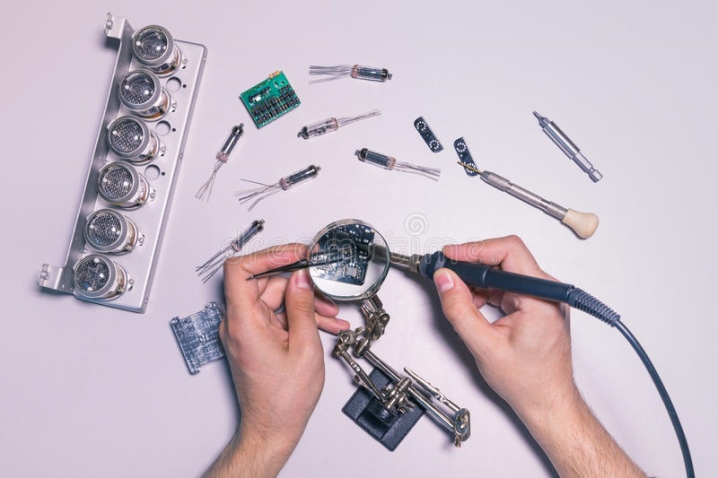Types
Magnifying glasses can be divided into types, which depend on the design features.
- Magnification degree. For devices that enlarge small objects, there is a certain rule: with an increase in the measurement frequency, the viewing angle decreases, but at the same time the object in question gets closer. The optimal ratio of the magnification factor and the viewing angle is considered to be the magnification factor of the object from 5 to 7 times. Depending on the degree of magnification, magnifiers are subdivided into devices with strong or weak approximation.
- Product design. A magnifying glass alone is not enough for the convenience of its use, and a certain holding structure is attached to it. Thanks to various design models, the magnifier has become very convenient to use. In retail chains, you can now find a wide variety of types of structures: on a bracket, on a flexible holder, on a stand, on a clothespin. There are long-handled magnifiers, headlamp options, table or floor models, cord magnifiers, keychain pocket magnifiers, and so on.
- Equipped with lighting. To improve the quality of view and when working with poor lighting levels, an illuminated magnifier is used. LEDs are most often used for backlighting. Illuminated magnifiers are in great demand; they are used in medicine and cosmetology, radio engineering and microelectronics, in the jewelry industry, the banking sector, and in everyday life.
- Lens material. Nowadays, lenses made of glass, plastic or acrylic polymers are widely used. The most budgetary option is a plastic magnifying glass, but this material is very unstable to mechanical stress and various scratches quickly appear on it. The most expensive and valuable lens material is glass. Of course, it will not withstand a fall from a height onto a solid foundation - a concrete floor or asphalt, but minor minor damage is not afraid of it. In the mid-priced category, there is an acrylic polymer that is more durable than conventional plastic, but inferior in quality to the properties of lenses made of glass.


Selection rules
A magnifying glass is an indispensable assistant, but in order to work with it comfortably, before choosing a model of a particular design, you need to try to take into account the following important points:
- determine what the magnifying glass will most often be used for and how long they will have to use;
- what shape, size and configuration the magnifier should be;
- Do you need a backlight, what intensity and spectrum it should be;
- what magnification the magnifying glass should have;
- how the magnifier will be attached for the convenience of your work;
- what material the magnifying glass will be made of.
As practice shows, a magnifying device is acquired for long-term use and for performing specific tasks.
When deciding on the choice, do not forget to take into account the ratio of quality and price, and also pay attention to the service life of the product
An overview of the NEWACALOX X5 desktop magnifier, see below.
Appointment
The magnifying glass is a versatile device that can be used to perform a wide variety of work with very small parts. The magnifier is used to repair phones, smartphones, computer equipment, and is used to solder boards in radio and electronic products.
Many critical components and parts that need to be repaired require precision and accuracy, such as in a watch movement, and here a magnifying glass comes to the rescue of the master, which greatly facilitates the work and allows you to achieve excellent results. In this case, magnifiers with illumination are considered more convenient, since most of the operations performed by the master require jewelry accuracy and a good view.

It is impossible to perform high-quality diagnostics if the inspection of parts is difficult due to their small size and poor illumination. In addition to diagnostics, a magnifying glass is also used to monitor the result of work performance. For example, the high quality of soldering or assembly guarantees trouble-free operation of the mechanism, which means that the repair was not done in vain.

If a person has reduced visual acuity, without a magnifying glass it will be difficult for him to read, write, embroider or perform other everyday activities that require clarity and a good view. The magnifier can be built-in illumination - LED or fluorescent lamps, and the size of the magnifying glass itself can be small or quite extensive. The magnifier can be bracket-mounted, floor-mounted or table-mounted. Most often, the design of a magnifier allows you to work with two hands without being distracted by its support.

